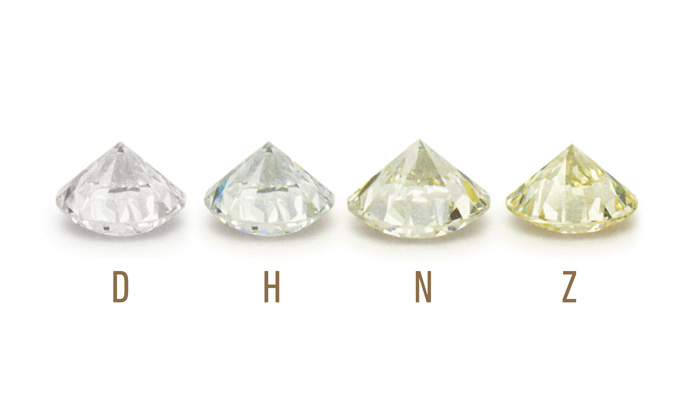Learn > The Four C’s > Color
• Sparkly User Guide
• The Four Cs
1. Carat
2. Cut
3. Color
4. Clarity
• Shapes
• Certification
• Settings
• Wedding Band Styles
• Metal Colors
Color
While this one may seem pretty self-explanatory, there are a lot of nuances to picking out the right color diamond.
While most of us aren’t judging the yellowness of our bff’s ring—let’s be honest, it’s usually the size—if you look really closely, you’ll probably notice a lot of diamonds that are slightly more yellow. What’s up with that?
Interestingly enough, a lot of diamond shoppers chose “lower-graded” diamonds that can appear to be slightly yellow in color.
When talking about traditional diamonds (not the intentionally yellow canary diamonds), the GIA has the following grading system:

The most interesting part about this grading system is that the employees grading diamonds have to inspect the diamonds from the side to determine an accurate color grade. Why would they look for the color of the diamond from a side-view instead of a top view since 95% of people look at it that way?
Two reasons:
- A well cut diamond is specifically designed to reflect while light through the top of the stone. This light can make the diamond look whiter when looking at it face-up, and doesn’t reflect the true color of the stone.
- The differences in each color grade is so teeny tiny, the graders need a clear view of the stone without the distractions of the sparkling light in order to accurately assess the color of the stone.
Color is so difficult to differentiate, that even the people whose job it is to grade diamonds are required to have a set of master stones to compare to side by side to get an accurate grade!
Soooo if even the professionals can’t immediately tell the differences in color, what makes you think you can? Unless you have some kind of diamond-seeing superpower, the chances are low that you can see such minute changes in color.

That being said, it’s generally known that it’s tough to tell the difference between the top 3 to 4 color grades without a master stone, especially when looking at it from the top. This means that nearly everyone will have trouble differentiating stones within the D-G colors if the stone is cut properly. This is where you can save some cash if you paid attention to our write up above about cut, but to save you the trouble of scrolling up, know this: you can save a good chunk of change getting a well-cut G stone over an ok-cut D stone.
Once you get into the I/K colors (and below), diamonds do take on a warmer appearance, but it’s seriously not the end of the world. Some people don’t mind (or even like) a diamond with a slightly yellow tint. Again, it’s very difficult to tell the difference when looking at the top of the stone, and even if the diamond does show its true colors, it will be difficult to tell if the diamond itself has a tint, or if it is picking up colors from your skin, a setting, or even the color of the room you are in.
It is worth noting that larger diamonds, and brilliant diamonds such as rounds are great at hiding the color through white light, whereas other shapes (cushion, radiant, emerald) can show more of those yellow tones since less light is reflected.
One last trick: A diamond with a yellow-gold setting will appear whiter than on a silver or white-gold setting. Because, contrast!